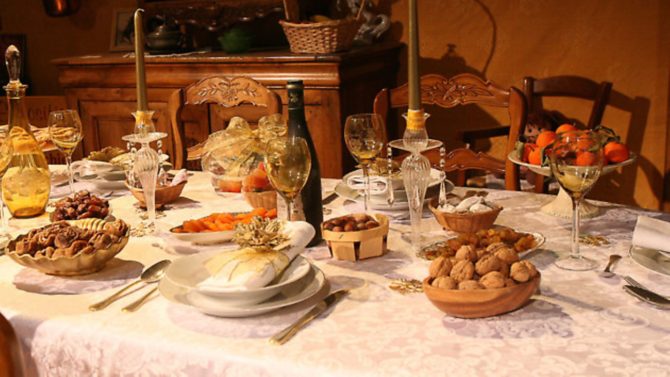The 13 traditional desserts eaten at Christmas in Provence

Traditionally, Christmas Eve dinner in Provence is followed by 13 desserts and guests have to try each one!
The custom in Provence is for 13 desserts to be served after the Gros Souper (Christmas Eve dinner) which represent Jesus and the 12 Apostles. The table is set with three tablecloths and three candles to represent the Holy Trinity and guests have to try a small (or big) serving of each dessert. The desserts can vary but here is a selection of common ones you might find if you are in Provence on Christmas Eve:
Dried fruit and nuts – The first four so-called ‘beggar’ desserts represent the four orders of friars: raisins (Dominicans); dried figs (Franciscans); almonds (Carmelites); and hazelnuts (Augustinians).
Fresh fruit – Fresh fruit also has pride of place, and can include tangerines, apples and pears, melon and/or grapes.
Pain d’épices – France’s own version of fruit cake is a staple of Christmas traditions throughout France.
Calissons d’Aix – This almond-shaped confectionery from Aix-en-Provence consists of a ground almond and fruit paste base with a royal icing topping.
Nougat – The sweet treat from Montélimar comes in hard black and soft white versions, which are said to represent good and evil. It is made with beaten egg whites (for the white nougat), honey, nuts and candied fruit.
Quince paste – Pâte de coing combines quince (a member of the apple and pear family) with sugar and goes well with the dried fruit.
Fougasse à l’huile – This flat cake (also known as pompe à l’huile) is always the final dessert. It is made with olive oil, sweetened with sugar and flavoured with orange flower water and grated orange and lemon zest. It must be torn, and never cut, and is dipped into ‘cooked wine’ (vin cuit), which is made by heating grape must to reduce it by half and then adding spices. Despite its name it is served cold.
Find out more about French Christmas traditions and festive events, plus learn how to say Merry Christmas and Happy New Year in French and make your own traditional French desserts
Share to: Facebook Twitter LinkedIn Email


